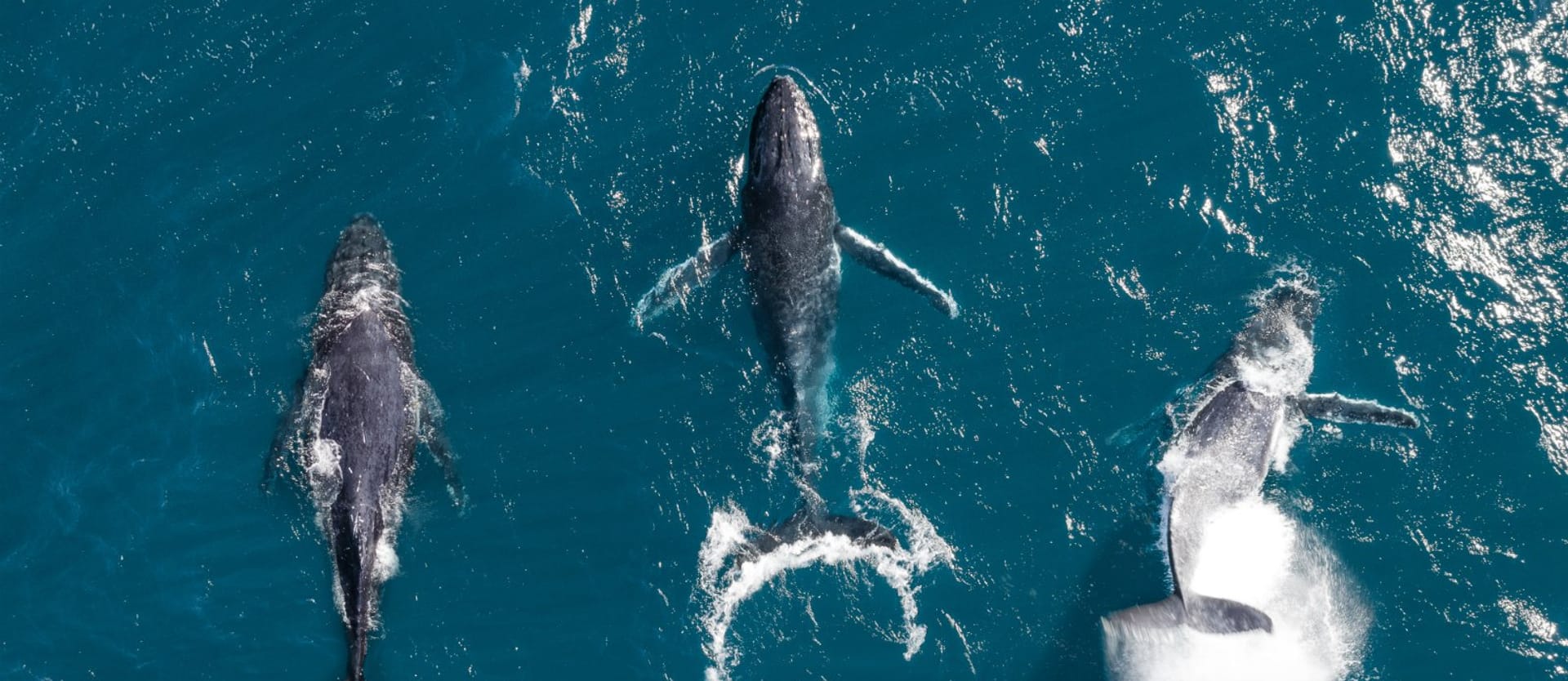GDS is one of the first abbreviations you learn in the travel business. Global distribution systems are responsible for providing booking websites with unified access to a massive inventory of flights, hotel rooms, car rental companies, cruises, and much more.
On our own TravelTech forum, we regularly get questions about the pros and cons of different GDSs, integration issues, and basic API information. We've tried to load our best intel about flight connectivity and hotel APIs into separate articles, but the GDS topic is relevant to everyone who's entering the travel booking world.
Here's our guide for understanding the three main GDSs and connecting to them.
What is GDS in travel?
A global distribution system, or GDS, is a computer network operating as a middleman between travel agents and numerous travel service providers. It collects inventory, schedules, and fares from suppliers and gives online travel agencies (OTAs) and other resellers an opportunity to search and book them using connectivity APIs or agent platforms.
The idea of a global distribution system first appeared due to the necessity of distributing flight tickets. Watch our video to understand better how it emerged and how it works.
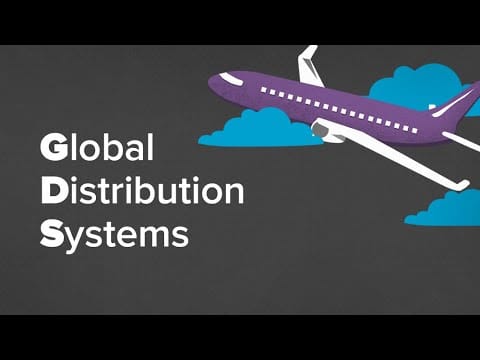

How airline distribution works
There are various large and local GDSs, but we will discuss the three main ones, covering almost every part of the world. They are Amadeus, Sabre, and Travelport (which combines Apollo, Galileo, and Worldspan).
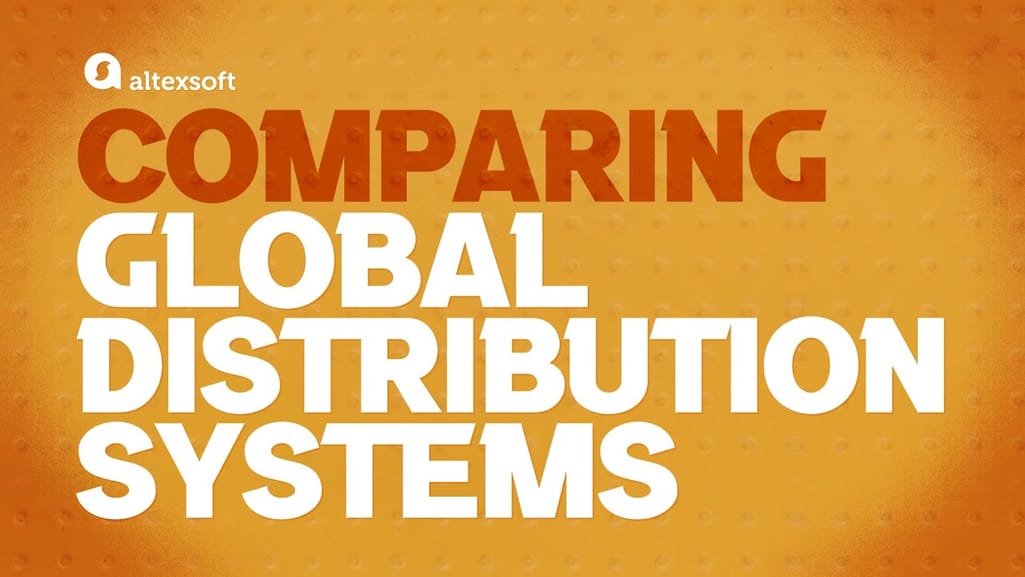

Amadeus vs Savre vs Travelport compared
Travel content and coverage
The future success of your agency partially depends on the diversity of options that you can suggest. After all, a GDS’s main advantage is providing a one-stop shop for various travel services. Here you can compare how broad the industry coverage of each GDS is.
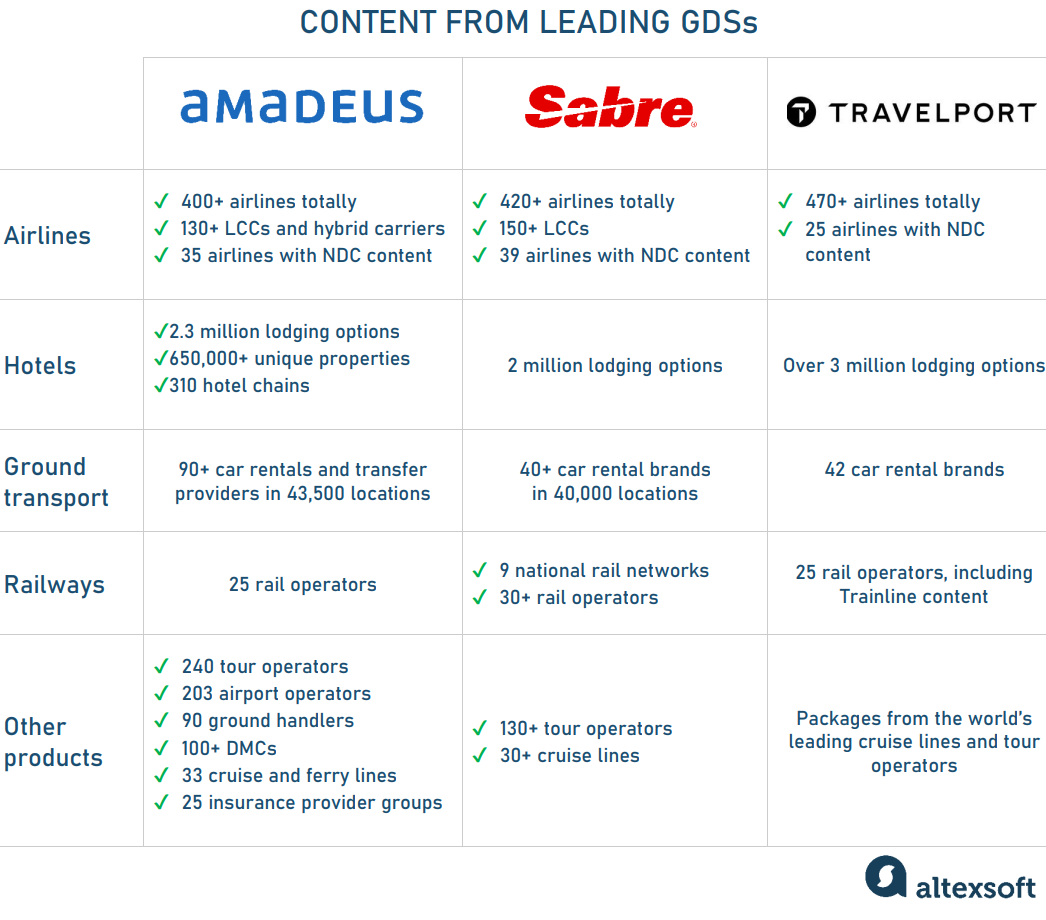
Hotels, flights, or cruises – choose the one that fits your business needs better
Amadeus inventory and coverage
Headquartered in Madrid, Amadeus was created in 1987 by four leading European airlines — Air France, Lufthansa, Iberia, and SAS. So, initially, its main area of distribution was the EMEA region (Europe, the Middle East, and Africa). Today, this GDS has a presence in 190 markets, with over one hundred offices worldwide, reaching more than 55,000 travel sellers.
Flights. Amadeus consolidates over 400 airlines, including 130+ hybrid and low-cost carriers (LCCs), including the number one European LCC, Ryanair. Additionally, more than a hundred airlines are available via interline agreements.
Besides bare seats, travel agencies can book ancillaries and fare families from over 150 and 130 suppliers, respectively. Sellers also enjoy real-time access to unique deals from 120 airlines that host their inventory in Altéa Reservation — a passenger service system (PSS) run by Amadeus.
Hotels. The GDS amasses over 650,000 unique properties with 2.3 million lodging options derived from leading bed banks and 310 hotel chains. It also provides access to thousands of alternative accommodations partnering with short-term rental aggregators such as Booking.com and TrustedStays. By the way, three of the world’s largest hotel groups—Marriott International, Accor, and IHG—chose a cloud-based central reservation system (CRS) built by Amadeus to streamline booking processes.
Other content. According to the Amadeus Global Report 2024, travel agencies can also take advantage of deals from
-
90+ car rentals and transfer providers covering 43,500 locations worldwide;
-
25 rail operators;
-
240 tour operators;
-
203 airport operators;
-
90 ground handlers;
-
33 cruise companies and ferry lines; and
-
25 insurance provider groups.
The travel content is available and bookable for resellers on the web-based Amadeus Selling Platform Connect, serving over 300,000 users in 200 markets.
Read more about booking platforms and other software for travel agencies in our dedicated article.
Sabre inventory and coverage
Sabre descends from a computer reservation system initially developed by American Airlines. Initially headquartered in Southlake (Texas), it now has five other major hubs—in Uruguay, the UK, Poland, India, and Singapore. Overall, Sabre operates around 50 offices in 30 countries, reaching customers in more than 160 countries globally and connecting 400,000+ online and offline travel agents to suppliers.
Flights. Sabre links sellers to over 420 airlines, both full-service carriers (FSCs) with traditional content and 150+ LCCs. Similar to Amadeus, Sabre runs its own passenger service system, SabreSonic.
Hotels. Sabre agents have access to over 2 million lodging options provided directly by hotel chains or via Sabre’s aggregator partners, which include Bedsonline (a part of HBX group also owning Hotelbeds), Booking.com, Expedia Partner Solutions, and Nuitée, a travel startup that offers infrastructure APIs for connectivity across the hospitality industry. Besides that, the Hyatt hotel group opted for Sabre as its CRS provider, with the inventory migration starting in 2024.
Other content. Sabre capitalizes on offers from
-
40+ car rental brands delivering services in 40,000 locations across 160 countries,
-
9 major national rail networks in North America and Europe (like Deutsche Bahn in Germany, SNCF in France, and Amtrak in the US) and 30+ rail operators,
-
30+ cruise lines via partnership with Traveltek, and
-
130+ tour operators.
Travel agents can tap into this multi-source content via SabreMosiac Travel Marketplace
Travelport content and coverage
Travelport, the smallest of the Big Three, actually combines three GDSs — Galileo, Worldspan, and Apollo. With its head office in Langley, Berkshire (a town just outside of London, UK), Travelport operates in 180 countries worldwide.
Flights. Travelport gives access to 470+ airlines, 360 branded fares, and ancillaries from 150 carriers.
Hotels. The GDS partners with 300+ global hotel brands and Booking.com, boasting over 3 million accommodation options. It guarantees commissions and perks from 45,000+ hotels.
Other content. Travelport offers content from
-
42 car rental brands, including Hertz pre-paid rates,
-
35 rail operators in Europe, Asia, and beyond, and
-
packages from leading cruise lines and tour operators.
In 2022, the GDS integrated with Trainline, Europe’s leading rail booking platform, enabling GDS clients to reserve and manage cross-European travel by train.
Travelport delivers content to sellers via its cloud and desktop tool, Smarpoint, which is built on top of the Travelport+ marketplace. It’s the fastest way to start selling travel with the GDS.
NDC support
New Distribution Capability, or NDC, is an industry initiative to drive modern retailing and a rich shopping experience across the air market. With major carriers such as Lufthansa, Air Canada, Air France-KLM, Emirates, and others imposing surcharges on bookings made via EDIFACT channels and offering the best fares only directly or through NDC-enabled partners, GDSs have adapted to this shift.
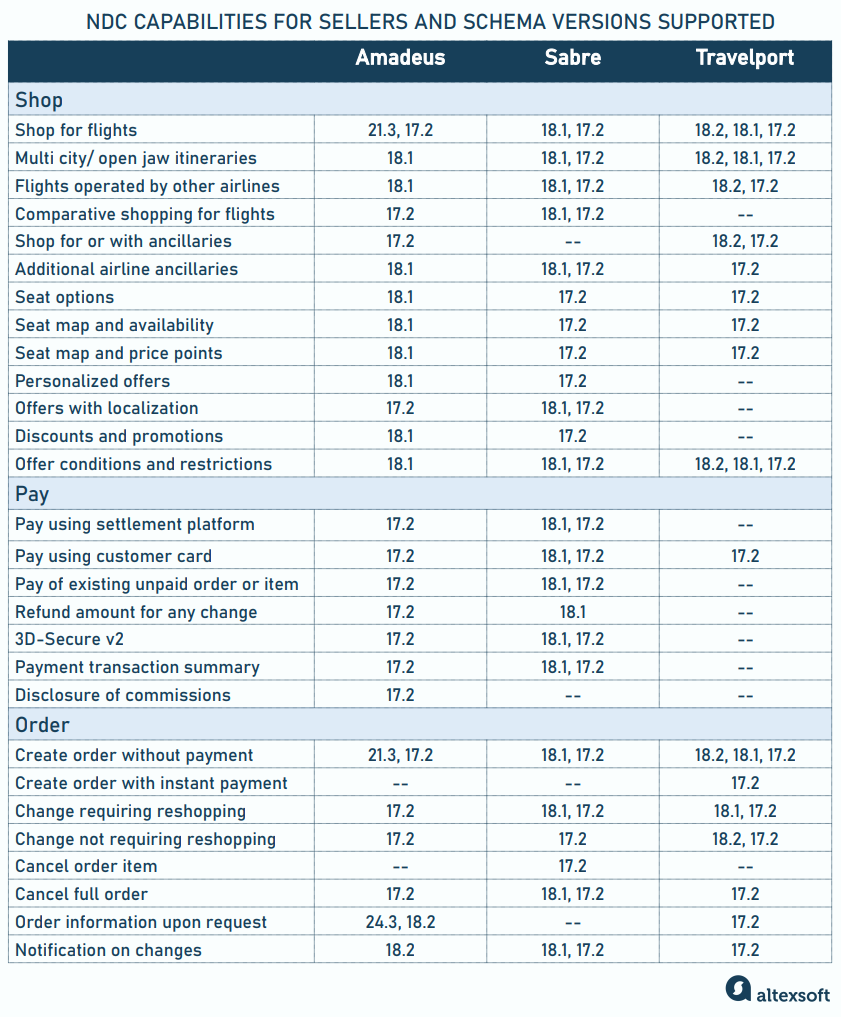
Retailing capabilities of GDSs as system providers for sellers and NDC schema versions supported. Source: ARM Index registry by IATA
The Big Three participate in the Airline Retailing Maturity (ARM) index program launched by IATA in 2022 to replace its 4-level NDC certification. The ARM index encompasses 75+ NDC capabilities divided into six groups: Shop, Order, Pay, Settle, Account, and Setup. Sabre and Amadeus are certified as system providers for both airlines and sellers, while Travelport offers NDC-enabled retailing functionality only on the seller side.
Most NDC capabilities are verified against version 17.2 of the NDC schema—the first stable release introduced in 2017—or on versions 18.1 and 18.2 (2018). The latest series, 24.1 and above, was introduced in 2025, with enhanced security, accounting, and interoperability features.
The list of airlines having strategic NDC partnerships with all three GDSs includes:
-
Air Canada
-
Air France-KLM
-
Air India
-
American Airlines
-
Avianca Group
-
British Airways
-
Cathay Pacific
-
Emirates
-
Etihad Airways (live on Amadeus and Sabre)
-
EVA Air
-
Finnair
-
Iberia
-
LATAM Group (currently live on Sabre only)
-
Lufthansa Group (encompassing Air Dolomiti, Austrian, Brussels, Discover, Lufthansa, and Swiss)
-
Malaysia Airlines
-
Qantas
-
Qatar
-
SAS
-
United
Read our guide on flight aggregators and the datasheet representing the NDC aggregator ecosystem with GDSs as part of this group.
Amadeus delivers content of 35 NDC airlines, covering 165 countries. It is currently the only GDS offering NDC products from
-
Vueling, Spanish LCC
-
IndiGo, the second-largest airline in Asia by passengers,
-
Japan Airlines, the second-largest airline in Japan (after ANA),
-
Jeju Air, South Korea’s first and largest LCC, and
-
three African carriers — Kenya Airways, Nile Air, and Tunis Air.
In 2025, Amedeus also strengthened its presence in the Middle East by launching NDC propositions of Saudia, the flag carrier of Saudi Arabia.
The NDC fares and ancillaries are available via XML-based SOAP APIs and Selling Platform Connect. The GDS supports 26 ARM capabilities for sellers and 37 features for airlines in Altéa Reservation PSS.
Sabre maintains exclusive access to NDC offers from Aeromexico, Hawaiian Airlines, Turkish Airlines, ANA (Japan's largest airline) and 6 carriers from the LATAM group (which is not yet live on other GDSs). Other carriers in its NDC portfolio are TAP Air Portugal and Saudia. Among expected NDC launches are
-
Riyadh Air, the second Saudi Arabian flag carrier after Saudia,
-
Royal Jordanian, the flag carrier of Jordan
-
Kenya Airways, and
-
WestJet, the second-largest FSC in Canada.
NDC content can be accessed on the SabreMosaic Travel Marketplace and via REST/JSON Offer and Order APIs. Overall, the GDS verified 25 ARM capabilities as a system provider for sellers and 3 capabilities as a system provider for airlines.
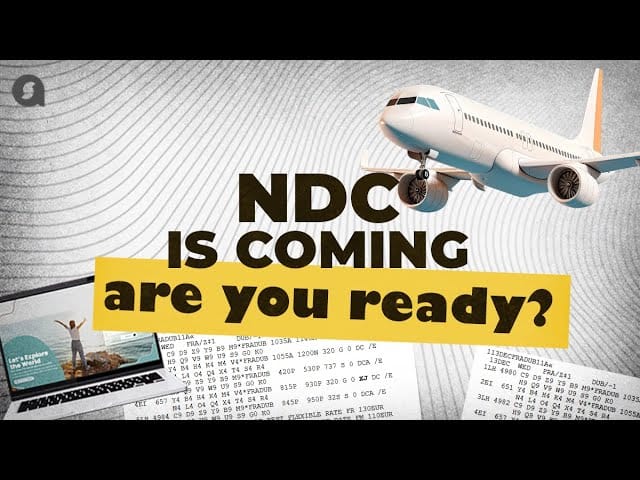

How NDC boosts airline retailing
Travelport is proud to be the first GDS to introduce the NDC channel. Currently, agencies can source deals from 25 NDC airlines via APIs, Travelport + retail platform, or Smartpoint Cloud interface. Among unique propositions are NDC fares by leisure-focused German carrier Condor. In the nearest future, Travelport is planning to go live with:
-
Aer Lingus, the Irish flag carrier,
-
Aeromexico,
-
ANA,
-
Virgin Atlantic,
-
Vueling, and
-
WestJet.
Travelport is also expanding its footprint in East Asia by striking NDC agreements with China Eastern Airlines (one of three major Chinese carriers), its subsidiary Shanghai Airlines, and UNI Airways (a Taiwanese airline belonging to the Evegreen group that also owns EVA Air.). The GDS verified 17 NDC capabilities as a system provider for sellers.
To understand what NDC is, its benefits, and implementation challenges, read our articles explaining NDC in air travel and NDC for airlines.
GDS API functionali
All three GDSs have a wide assortment of travel APIs to power travel agency software, tour operator tools, B2B travel platforms, car rental reservation systems, and other solutions.
Amadeus APIs
Amadeus was the first GDS to launch APIs back in 2000. Today, Amadeus APIs, powering thousands of web and mobile applications, fall into two large categories — Self-Service for newcomers and travel startups and Enterprise for big players.
The Self-Service subscription comes with APIs based on modern REST architecture and supporting JSON format for data exchange. Currently, APIs in five categories are available for building booking engines and other types of travel software. Amadeus provides SDKs to speed up development with Python, Java, and Node.js.
Flight APIs automate the flight booking process, from searching to branded fares upselling to cancellations. You can also take advantage of additional features such as travel recommendations, flight delay predictions, finding all destinations served by a particular airline, and many more. Note that APIs in the Self-Service catalog don’t allow for airline ticketing, so you need to complete the booking process with a partner host agency or air consolidator. Also, flights from low-cost carriers, American Airlines, Delta, and British Airways are currently unavailable.
Cars and Transfers APIs facilitate transportation arrangements by standardizing content from global providers, completing bookings, and allowing you to manage and cancel reservations easily. Car rental APIs cover private transfers, taxis, airport express trains and buses, private jets, transfer helicopters, and more.
Hotel APIs enable room shopping across 150,000 hotels, returning the cheapest lodgings in a given location. You can also filter options by category, chain, facilities, or budget. The search is facilitated with autocomplete functionality. You can also enrich results with travel ratings — the correspondent API applies sentiment analysis to hotel reviews.
Destination Experiences APIs give you access to over 300,000 tours and activities, returning
-
a ranked list of attractions for a specific area, with coordinates, categories, and popularity scores calculated by the AVUXI TopPlace algorithm, processing millions of online comments and photos; and
-
a list of top activities for a given location with links to complete booking with a provider.
The deals come from leading experience aggregators like Viator owned by TripAdvisor and GetYourGuide.
Market Insights APIs enable you to make decisions based on information about the most traveled and booked destinations and the busiest travel periods. The insights are extracted from Amadeus's historical flight data, including traffic summary and the total number of passenger name records PNRs) created.
The Enterprise subscription encompasses the Self-Service catalog and old-style SOAP APIs, which still prevail in Amadeus's portfolio. It offers the following key capabilities unavailable in the Self-Service tier:
-
air ticketing at booking time,
-
adding a frequent flyer number to a PNR,
-
more booking and post-booking operations in the EDIFACT flow,
-
creating and managing a customer profile,
-
NDC content booking,
-
generating virtual credit cards and paying with them, and
-
rail booking.
Besides rich functionality, enterprise clients enjoy 24/7 technical support, customized pricing, and the services of a dedicated manager, but to join the club, you must be IATA/ARC-certified.
Note that Amadeus doesn’t reveal cruise content via APIs making it available only on its cruise portal.
To dive deeper into business and technical details, read about our hands-on experience with Amadeus API integration.
Sabre APIs
Sabre leverages both SOAP APIs and REST APIs, with the former offering richer functionality and the latter being more developer-friendly. The connectivity suite encompasses
-
Air APIs, including REST/JSON Offer and Order APIs to integrate NDC, ATPCO, and low-cost deals;
-
Hotel APIs;
-
Car APIs; and
-
Rail APIs.
Besides separate endpoints, Sabre offers orchestrated APIs that join multiple operations into a single call. For instance, you can search for air options, check availability and prices, and book a flight (create a PNR) in one request. Other pre-built workflows are air ticket issuing, NDC air offer fulfilment, car reservation, and more.
To better understand how to tap into Sabre APIs, read about our hands-on experience with Sabre API integration.
Travelport APIs
Travelport offers a Universal API (SOAP XML) that connects you to a range of products through a single point of access. It enables shopping and booking of
-
air (EDIFACT, NDC and LCC content);
-
hotels;
-
cars; and
-
rails.
Travelport regularly new versions of the Universal API schema and recommends upgrading integrations at least once a year.
GDS tools for sellers
Today, GDSs work not only as content aggregators: They are also the largest tech providers in travel. In addition to APIs, Amadeus, Sabre, and Travelport offer a wide range of ready-to-use software products for leisure travel agencies, travel management companies (TMCs), tour operators, airlines, hotels, and other players. Here, we’ll do a short review of key off-the-shelf solutions for travel sellers.
Amadeus Selling Platform Connect, Cytric, and Outpayce
A major product of Amadeus — Selling Platform Connect — enables travel agents to work from any device and any location with an Internet connection. Targeting small and medium businesses, the cloud-based platform requires no installation and enjoys automated updates, so everyone in the organization uses the same version.
Amadeus also has a separate suite of solutions for corporate travel management — Cytric Travel and Expense. It comes with a mobile app for traveling employees, expense management tools, intuitive dashboards, CO2 compensation reports, and more.
In 2022, the company launched the B2B payments platform Outpayce, fully integrated with the Amadeus tech ecosystem. It allows travel sellers to pay their suppliers with virtual cards and create and manage B2B wallets. The solution connects travel businesses with over 50 card issuers.
Read our article on virtual credit cards in travel to learn about the benefits and drawbacks of this payment method, or watch the dedicated video explainer.


Virtual cards in travel explained
Sabre Red 360, SabreMosaic Travel Marketplace, and Conferma Pay
Sabre agents can take advantage of Sabre Red 360, a desktop connecting sellers to suppliers. It covers the content accessible via APIs, including NDC offers. In 2023, platform users started to receive carbon offset data when searching for flights. This option enables them to identify the biggest air polluters and make bookings with sustainability in mind.
One of the content sources for Red 360 is SabreMosaic Travel Marketplace, an aggregation engine that normalizes data from different sources. It’s not only aligned with the modern offer and order retailing framework but also leverages an AI agentic layer backed by a model context protocol (MCP). Among the features available are AI agents for automated rebooking during disruptions, confirming hotel reservations late at night, arranging special requests, and filling visa applications.
Similar to Amadeus, Sabre owns a B2B payment platform — in 2022, the GDS acquired its longstanding partner Conferma Pay. It links travel businesses with over 50 banks capable of releasing virtual credit cards in 100 currencies.
Travelport +, Smartpoint Cloud,and Deem
Since 2021, Travelport has been actively enhancing its retailing platform, Travelport+. In 2023, the company introduced Smartpoint Cloud, an agent-facing interface that enables sellers to create tailored travel packages more efficiently. A year later, it added an AI-powered search designed to remove duplicate results and highlight the most relevant, profitable options. This innovation helps agents save time and focus on higher-value tasks such as upselling and personalization.
Another development is the integration of Travelport+ with the corporate booking tool Deem, which covers all the content available on Travelport+, including NDC deals.
As for B2B payments, Travelport doesn’t follow the trend. Instead of purchasing a platform to streamline transactions, the company got rid of one in 2020. Namely, it sold its payment business eNett and its parent company Opal, to rival brand WEX.
Pricing and time-to-marke
One of the primary concerns of any business is the price of integrated technology. None of the three major GDSs will give you a straight answer. Amadeus, Sabre, and Travelport want you to contact them directly to get the details.
The pricing on any GDS will likely be shaped based on the following factors:
- the market you would like to expand on;
- the technologies you’re going to use;
- your selling volumes (which directly impact the number of API calls); and
- the quality and quantity of content you want to obtain.
Subsequently, for any of the three GDSs, it’s impossible to predict the time to market. We can at least say that it depends on how fast you are ready to pay the quoted amount of money, how well your product strategy is built, and whether a suggested technology is easily compatible with your existing system.
Unlike modern booking platforms, a native GDS workspace, commonly called a green screen or terminal, has a command-line interface with text-based inputs and outputs. So navigating Amadeus, Sabre, or Travelport is a complex technical skill that involves proficiency in operating and understanding a lot of domain-specific commands and codes. No wonder becoming a GDS expert takes intense training and constant practice (daily booking under mentor supervision for six months to a year.)
GDS systems: how to connect to them
Thanks to the rise of Internet booking engines, you no longer need to know all ins and outs of a GDS to buy travel. However, working directly with a global distribution system gives you a lot of benefits over non-GDS agents — especially when it comes to flights. First-hand access to GDSs remains the fastest and most efficient way to find and reserve airline tickets at attractive prices. Here are standard steps for tapping into a GDS of your choice.
Apply for acceptance
To become a GDS agent, contact a provider and complete an application form. For this step, you have to submit information about your business, such as proof of past performance and industry certifications. For example, if you’re going to handle air ticketing, it’s mandatory to have IATA accreditation (or IATAN/ARC numbers for US travel agencies.)
Look through our comprehensive guides on how to get IATA accreditation, ARC accreditation options, and Airline Reporting Corporation and IATA Billing and Settlement Plan.
Small businesses and individual travel agents that can’t afford pricey industry accreditations can book travel under the umbrella of a host travel agency or an air consolidator. In this case, you need to submit your host’s credentials.
To grasp how this scenario works, read about host travel agencies, airline consolidators overview, and booking and ticketing for non-IATA travel agencies.
Pass the GDS terminal training
Unlike modern booking platforms, a native GDS workspace, commonly called a green screen or terminal, has a command-line interface with text-based inputs and outputs. So navigating Amadeus, Sabre, or Travelport is a complex technical skill that involves proficiency in operating and understanding a lot of domain-specific commands and codes. No wonder becoming a GDS expert takes intense training and constant practice (daily booking under mentor supervision for six months to a year.)
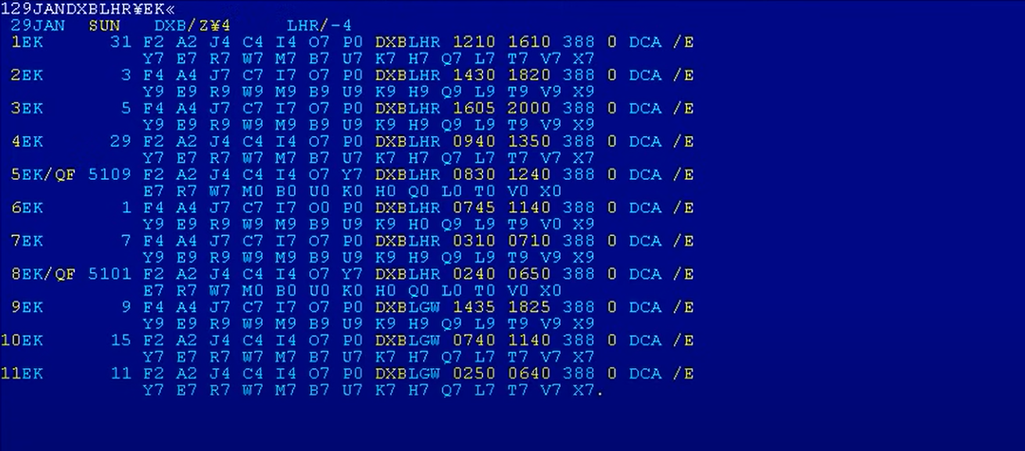
That’s what a Sabre green screen looks like
While all global distribution systems are very much alike, each of them has its own distinctions so you must focus on the one you will actually use. There are a lot of relevant courses provided by GDSs, IATA, and educational platforms like Udemy. The price varies depending on duration, level (basic, advanced, etc.), particular knowledge areas covered, and other factors.
Besides old-school terminals, GDSs offer more modern, user-friendly interfaces for travel agents, such as Sabre Red 360, Amadeus Selling Platform Connect, and Travelport+. They significantly cut training time and enhance productivity. Yet you still need to switch from GUI to manual commands to complete the reservation. That’s why global distribution systems require users to accomplish a GDS-provided or approved training course to get access to their innovative products. Note that even the slightest errors made during the booking result in debit memos — fines paid by travel agencies.
Negotiate competitive deals
The success of your GDS cooperation depends on the relevancy of data being submitted by suppliers. So, to obtain the most profitable and beneficial deals from suppliers via GDSs, you should arrange them yourself. GDSs, in turn, allow you to establish the rates negotiated with providers.
Integrate with GDS APIs
Instead of a manual search routine via GDS interfaces, online travel agencies can automatically source and book travel content using GDS APIs. The process of API integration requires a skilled tech workforce and involves additional contracts and negotiations. It may take from several weeks to several months to develop and test connections as well as certify them with a GDS.
Negotiate competitive deals
The success of your GDS cooperation depends on the relevance of data being submitted by suppliers. So, to obtain the most profitable and beneficial deals from suppliers via GDSs, you should arrange them yourself. GDSs, in turn, allow you to establish the rates negotiated with providers.
Integrate with GDS APIs
Instead of a manual search routine via GDS interfaces, online travel agencies can automatically source and book travel content using GDS APIs. The process of API integration requires a skilled tech workforce and involves additional contracts and negotiations. It may take from several weeks to several months to develop and test connections as well as certify them with a GDS.
If not GDS, then what? Alternatives to keep in min
Generally speaking, GDSs have two main use cases:
- Travel agencies, OTAs, and TMCs that are striving to cover all travel management needs; and
- Travel agencies, OTAs, and TMCs where air flight distribution is an integral part of the business.
That being said, GDSs are the main source of inventory for flight distribution. So, if your main focus is hotels, consider other options.
Large OTAs
Anyone working in the travel industry can hardly deny the power of OTA mammoths Expedia and Booking.com. Being dominant in the market, they can also provide distribution support to a smaller business, taking their own profit from it.
Expedia Group has over 1 million properties across its subsidiaries. They can be accessed via Expedia Partner Solutions, which provide access to
-
3 million global accommodations across 35 property types,
-
170,000 activities,
-
110+ car rental companies,
-
3,900+ ground transportations,
-
500+ airlines, and
-
special hotel rates (up to 20 percent lower than published prices) when creating packages.
Expedia Group also offers a suite of REST-based Rapid APIs. The Rapid Lodging API powers the end-to-end accommodation booking flow for OTAs and other platforms. It provides content for over 750,000 properties, including detailed information such as star ratings (assigned either by Expedia Group or a local organization). Other APIs — Rapid Cars, Rapid Flights, and Rapid Activities — are currently in their pilot phase.
Booking.com currently has over 28 million accommodations, plus transportation options, and attractions listed in an affiliate program. The platform also exposes a Demand API that supports both XML and JSON formats and covers:
-
live rates and availability,
-
hotel content, and
-
booking processing capabilities.
The API not only provides the widest variety of accommodations online but also enables you to choose which options will appear on your website in the first place. It also helps with keeping track of your earnings.
Wholesalers
For many OTAs, wholesalers or bed banks are the main source of inventory. Some large players, like Hotelbeds, tend to offer high-level customer service, advanced APIs, large inventory, and further expansion in the market.
In this distribution model, a wholesaler signs a contract with a hotel for a particular period of time to sell a set of its rooms for a fixed price. The rooms are then sold to OTAs and TMCs. Hotels and wholesalers are striving to keep their rooms filled to capacity and resort to having to negotiate special room rates.
Read our dedicated articles explaining the role of bed banks in hotel distribution and comparing major bedbanks.
Direct connections to providers
Direct connectivity to transport and hospitality providers is also one of the appropriate options to focus on. Usually, it’s available via two-way API communication that allows exchanging data between different systems. With the direct connection, an OTA avoids middlemen and gets relevant and updated content. The fewer third parties there are, the more competitive pricing you have.
Which GDS system is the best?
No doubt, GDSs are the best at... globally covering distribution for travel networks. Sure, they have drawbacks like extensive requirements, long confirmation processes, and abundant resource consumption. And there’s still room for growth for GDS adoption of low-cost carriers and NDC content.
Apart from that, there’s no straight answer to the question of which GDS is better: Amadeus, Sabre, or Travelport. The answer is more complicated, and we hope this article helped clarify things.
If your travel company is not that tech-savvy, employ a travel technology consultant, and consider other options.
